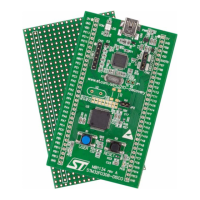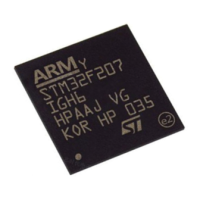RM0008 Real-time clock (RTC)
Doc ID 13902 Rev 12 471/1096
The functions of the RTC are controlled by this control register. It is not possible to write to
the RTC_CR register while the peripheral is completing a previous write operation (flagged
by RTOFF=0, see Section 18.3.4 on page 467).
Note: 1 Any flag remains pending until the appropriate RTC_CR request bit is reset by software,
indicating that the interrupt request has been granted.
2 At reset the interrupts are disabled, no interrupt requests are pending and it is possible to
write to the RTC registers.
3 The OWF, ALRF, SECF and RSF bits are not updated when the APB1 clock is not running.
4 The OWF, ALRF, SECF and RSF bits can only be set by hardware and only cleared by
software.
5 If ALRF = 1 and ALRIE = 1, the RTC global interrupt is enabled. If EXTI Line 17 is also
enabled through the EXTI Controller, both the RTC global interrupt and the RTC Alarm
interrupt are enabled.
6 If ALRF = 1, the RTC Alarm interrupt is enabled if EXTI Line 17 is enabled through the EXTI
Controller in interrupt mode. When the EXTI Line 17 is enabled in event mode, a pulse is
generated on this line (no RTC Alarm interrupt generation).
18.4.3 RTC prescaler load register (RTC_PRLH / RTC_PRLL)
The Prescaler Load registers keep the period counting value of the RTC prescaler. They are
write-protected by the RTOFF bit in the RTC_CR register, and a write operation is allowed if
the RTOFF value is ‘1’.
RTC prescaler load register high (RTC_PRLH)
Address offset: 0x08
Write only (see Section 18.3.4 on page 467)
Reset value: 0x0000
15 14 13 12 11 10 9 8 7 6 5 4 3 2 1 0
Reserved
PRL[19:16]
wwww
Bits 15:4 Reserved, forced by hardware to 0.
Bits 3:0 PRL[19:16]: RTC prescaler reload value high
These bits are used to define the counter clock frequency according to the following formula:
f
TR_CLK
= f
RTCCLK
/(PRL[19:0]+1)
